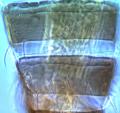Oxythrips divisus
Recognition data
Distinguishing features
Both sexes fully winged. Body color yellow, antennal segments III–IX brown, fore wings shaded. Antennae with segment VI partially divided, thus apparently 9-segmented; sensoria on III–IV forked. Head with three pairs of ocellar setae, pair III on anterior margins of ocellar triangle and slightly longer than distance between posterior ocelli. Pronotum with one pair of long posteroangular setae. Metanotum reticulate, median setae just behind anterior margin; campaniform sensilla present. Fore wing first vein with three setae on distal half, second vein with about 11 setae. Abdominal tergites with median pair of setae not close together; tergite VIII without a marginal comb; sternites without discal setae.
Male with small circular pore plate on sternites III–VII; tergite IX with two pairs of short stout setae medially.
Related and similar species
Bailey (1957: 189) recorded the European species Oxythrips quercicola Bagnall from Pinus and Quercus in California, but subsequent examination of Bailey's specimens indicates that this was a misidentification. The genus is thus known to occur in California, but the identity of the species involved remains unknown. In order to ensure that the genus can be recognized within the Californian fauna, the eastern USA species, O. divisus, is included here. The genus Oxythrips includes 50 species, almost all from the northern Hemisphere apart from 12 that are known only from fossils. The species are very similar in structure to the species of Anaphothrips but have one pair of elongate pronotal posteroangular setae, and the species of Chilothrips are also similar, but have the mouth cone unusually elongate.
Taxonomic data
Current valid name
Oxythrips divisus Hood
Original name and synonyms
- Oxythrips divisus Hood, 1916: 39
Family placement
Thripidae, Thripinae
Biological data
Life history
Probably breeding in male cones
Host plants
Apparently Pinus spp.
Tospoviruses vectored
None
Crop damage
None
Distribution data
Area of origin
Eastern USA
Distribution
Maryland, Illinois [not known from California, see comment on related species]





